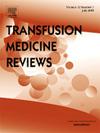The Utility of a Critical Antibody Titer in Anti-K Alloimmunized Pregnancies: A Systematic Review and Meta-Analysis of Diagnostic Test Accuracy
IF 2.5
2区 医学
Q2 HEMATOLOGY
引用次数: 0
Abstract
Anti-Kell (anti-K) alloimmunization is a known cause of severe hemolytic disease of the fetus and newborn (HDFN), yet the utility of a critical maternal antibody titer in guiding clinical management remains debated. We conducted a systematic review and meta-analysis to evaluate the diagnostic accuracy of a maternal anti-K titer threshold of ≥8 for predicting the need for intrauterine intervention due to severe anti-K–mediated HDFN. In parallel, we characterized all reported cases of severe HDFN occurring in the setting of low maternal anti-K titers (<8). Studies were excluded if they lacked reported titers, did not include K-positive or K-unknown fetuses, failed to report fetal outcomes, or included interventions that could lower maternal alloantibody levels. Studies that assessed all alloimmunized patients meeting inclusion criteria were incorporated into a diagnostic test accuracy (DTA) meta-analysis; all eligible studies were included in a qualitative synthesis. Fifty-four studies, comprising 582 fetuses, met inclusion criteria. Of these, 6 studies (350 fetuses) were included in the DTA analysis, which demonstrated a pooled sensitivity of 97.0% (95% CI, 88.7%–99.2%) and specificity of 33.1% (95% CI, 27.9%–38.8%) for an anti-K titer ≥8. Among fetuses affected by severe HDFN, 98.6% (204/207) were associated with maternal anti-K titers ≥8. These findings suggest that severe disease is uncommon in the setting of low anti-K titers and support the use of a critical titer threshold to inform antenatal surveillance. Reevaluation of current clinical guidelines may be warranted in light of these data.
关键抗体滴度在抗k异体免疫妊娠中的效用:诊断测试准确性的系统回顾和荟萃分析
抗kell(抗k)同种异体免疫是胎儿和新生儿严重溶血性疾病(hddn)的已知原因,但关键母体抗体滴度在指导临床管理中的效用仍存在争议。我们进行了一项系统回顾和荟萃分析,以评估母体抗k滴度阈值≥8用于预测因严重抗k介导的HDFN而需要宫内干预的诊断准确性。同时,我们描述了所有报告的发生在低母体抗k滴度环境下的严重hdn病例(<8)。如果缺乏报告的滴度,不包括k阳性或k未知的胎儿,未报告胎儿结局,或包括可能降低母体同种异体抗体水平的干预措施,则排除研究。评估所有符合纳入标准的同种异体免疫患者的研究被纳入诊断测试准确性(DTA)荟萃分析;所有符合条件的研究纳入定性综合。54项研究,包括582名胎儿,符合纳入标准。其中,6项研究(350例胎儿)被纳入DTA分析,结果显示抗k滴度≥8的合并敏感性为97.0% (95% CI, 88.7%-99.2%),特异性为33.1% (95% CI, 27.9%-38.8%)。在患有严重hdf的胎儿中,98.6%(204/207)与母体抗k滴度≥8相关。这些发现表明,严重的疾病是罕见的设置低抗k滴度和支持使用临界滴度阈值,以通知产前监测。根据这些数据,可能需要重新评估当前的临床指南。
本文章由计算机程序翻译,如有差异,请以英文原文为准。
求助全文
约1分钟内获得全文
求助全文
来源期刊

Transfusion Medicine Reviews
医学-血液学
CiteScore
11.60
自引率
0.00%
发文量
40
审稿时长
21 days
期刊介绍:
Transfusion Medicine Reviews provides an international forum in English for the publication of scholarly work devoted to the various sub-disciplines that comprise Transfusion Medicine including hemostasis and thrombosis and cellular therapies. The scope of the journal encompasses basic science, practical aspects, laboratory developments, clinical indications, and adverse effects.
 求助内容:
求助内容: 应助结果提醒方式:
应助结果提醒方式:


